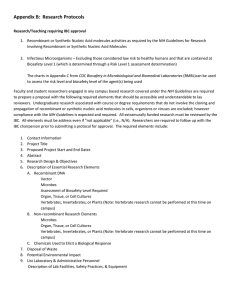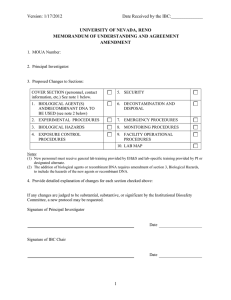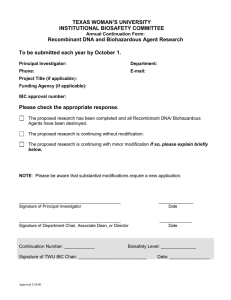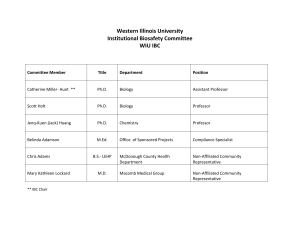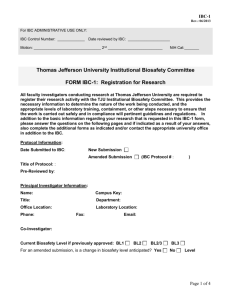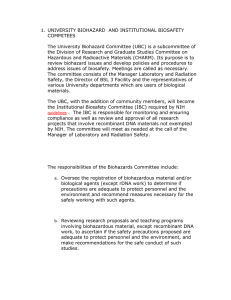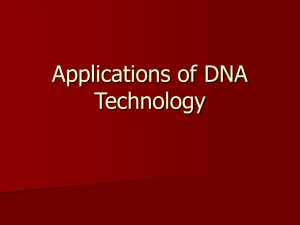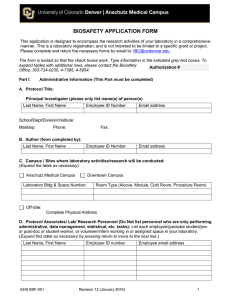Recombinant DNA Registration Document
advertisement
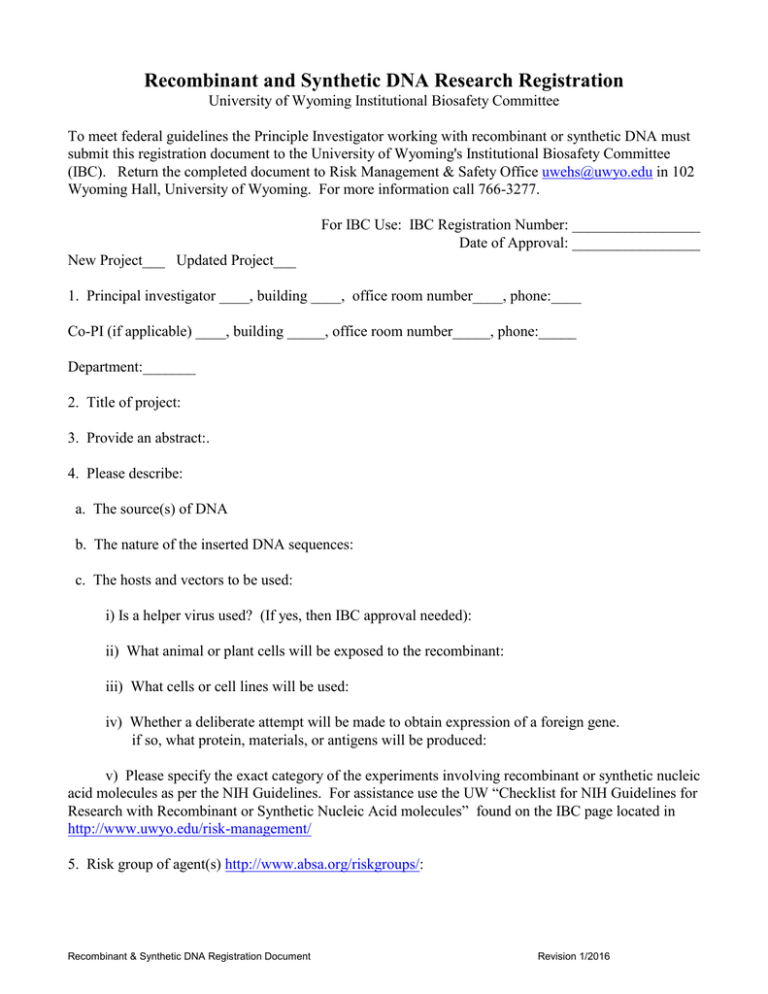
Recombinant and Synthetic DNA Research Registration University of Wyoming Institutional Biosafety Committee To meet federal guidelines the Principle Investigator working with recombinant or synthetic DNA must submit this registration document to the University of Wyoming's Institutional Biosafety Committee (IBC). Return the completed document to Risk Management & Safety Office uwehs@uwyo.edu in 102 Wyoming Hall, University of Wyoming. For more information call 766-3277. For IBC Use: IBC Registration Number: _________________ Date of Approval: _________________ New Project___ Updated Project___ 1. Principal investigator ____, building ____, office room number____, phone:____ Co-PI (if applicable) ____, building _____, office room number_____, phone:_____ Department:_______ 2. Title of project: 3. Provide an abstract:. 4. Please describe: a. The source(s) of DNA b. The nature of the inserted DNA sequences: c. The hosts and vectors to be used: i) Is a helper virus used? (If yes, then IBC approval needed): ii) What animal or plant cells will be exposed to the recombinant: iii) What cells or cell lines will be used: iv) Whether a deliberate attempt will be made to obtain expression of a foreign gene. if so, what protein, materials, or antigens will be produced: v) Please specify the exact category of the experiments involving recombinant or synthetic nucleic acid molecules as per the NIH Guidelines. For assistance use the UW “Checklist for NIH Guidelines for Research with Recombinant or Synthetic Nucleic Acid molecules” found on the IBC page located in http://www.uwyo.edu/risk-management/ 5. Risk group of agent(s) http://www.absa.org/riskgroups/: Recombinant & Synthetic DNA Registration Document Revision 1/2016 6. Concisely describe the hazards of the agents involved: a. Is the agent a select agent? b. Does the agent produce a lethal toxin? If so describe: 7. Location of experiments (list all locations by building and room number): 8. Location of agent storage: 9. Biocontainment a. Physical containment level required (Biosafety level) b. Biosafety cabinet location and certification date: 10. Personal Protective Equipment (PPE) required: 11. Identify pre-exposure vaccines or other medical treatment in advance of working with the agent: 12. Please describe treatment in the event of an accidental exposure and whether it is locally available: 13. Location of Pathogen Safety Data Sheet, inventory log, laboratory biosafety manual: 14. Describe or attach laboratory emergency procedures (i.e. in the case of spills of chemicals or infectious materials, or a medical emergency): 15. Do the proposed experiments include infection of animals? Yes or no ____ a. If so, briefly describe the procedures and study locations. b. How are animals and animal wastes treated and disposed? 16. Does the experiment involve single containers of cultures greater than one liter of agent? If so how much: 17. Describe agent handling and experimental procedures: 18. Describe decontamination and disposal procedures (autoclave parameters, disinfectants used, etc.): 19. All personnel authorized to handle organisms must complete CITI online training (Basic Biosafety Training, NIH recombinant DNA Guidelines, and other appropriate modules) before initiating the protocol. Find the link to CITI training at the bottom of the IBC page located in http://www.uwyo.edu/risk-management/ For more information contact uwehs@uwyo.edu. List personnel authorized to handle organisms and applicable training: Personnel: CITI Training Completion Date: Other Applicable Training: Recombinant & Synthetic DNA Registration Document Revision 1/2016 The information above is accurate and complete. I am familiar with and agree to abide by the provisions of the current NIH Guidelines for Research Involving Recombinant or Synthetic Nucleic Acid Molecules (NIH Guidelines), and other specific NIH instructions pertaining to the proposed project. I agree to abide by the following requirements. Please initial each statement. ___ Be adequately trained in good microbiological techniques. ___ Provide laboratory research staff with protocols describing potential biohazards and necessary precautions. ___ Instruct and train lab staff in (i) the practices and techniques required to ensure safety, and (ii) the procedures for dealing with accidents. ___ Inform the lab staff of the reasons and provisions for precautionary medical practices advised or requested (e.g., vaccinations or serum collection). ___ Supervise lab staff to ensure that the required safety practices and techniques are employed. ___ Correct work errors and conditions that may result in the release of recombinant or synthetic nucleic acid materials. ___ Ensure the integrity of physical containment (e.g., biological safety cabinets) and biological containment (e.g., host-vector systems that preclude survival of the agent outside the lab). ___ Comply with permit and shipping requirements for recombinant or synthetic nucleic acid molecules. ___ Adhere to the IBC-approved emergency plan described above for this project for handling accidental spills and personnel contamination. ___ Submit any subsequent changes (e.g., changes in the source of DNA or host-vector system) to the IBC for review and approval or disapproval. ___ Remain in communication with the IBC throughout the duration of the project (e.g., Annual updates and/or major changes to the project). ___ Report any significant problems pertaining to the operation and implementation of the containment practices and procedures, violations of the NIH Guidelines, or any significant research-related accidents and illnesses to the IBC, NIH-OBA, Biological Safety Specialist, and as applicable the Animal or Greenhouse Facility Director, and other appropriate authorities. Principle Investigator:________________________________________________Date_______________ Signature RETURN THIS DOCUMENT TO: Biological Safety Specialist, uwehs@uwyo.edu, Risk Management & Safety Office, 102 Wyoming Hall, University of Wyoming. For questions call 766-3277. Recombinant & Synthetic DNA Registration Document Revision 1/2016
